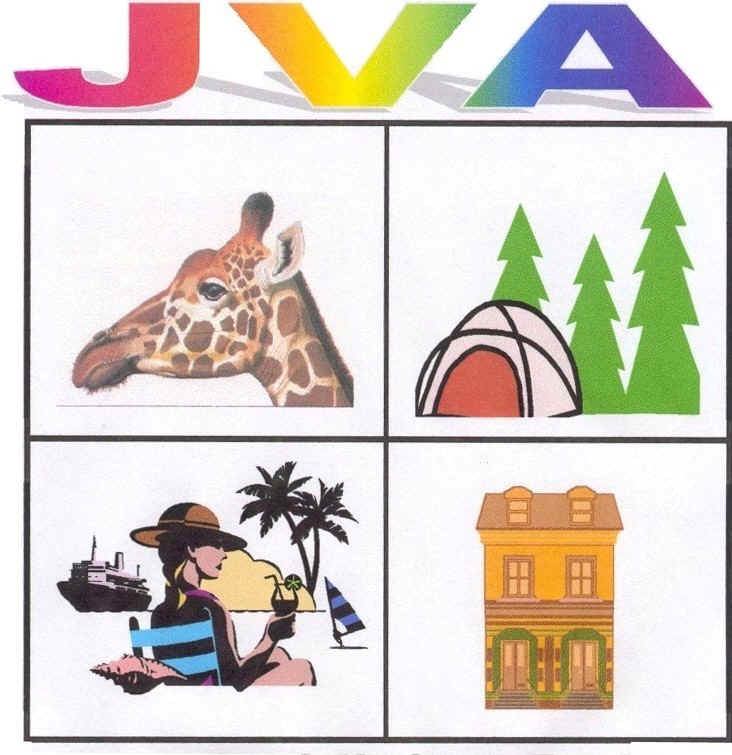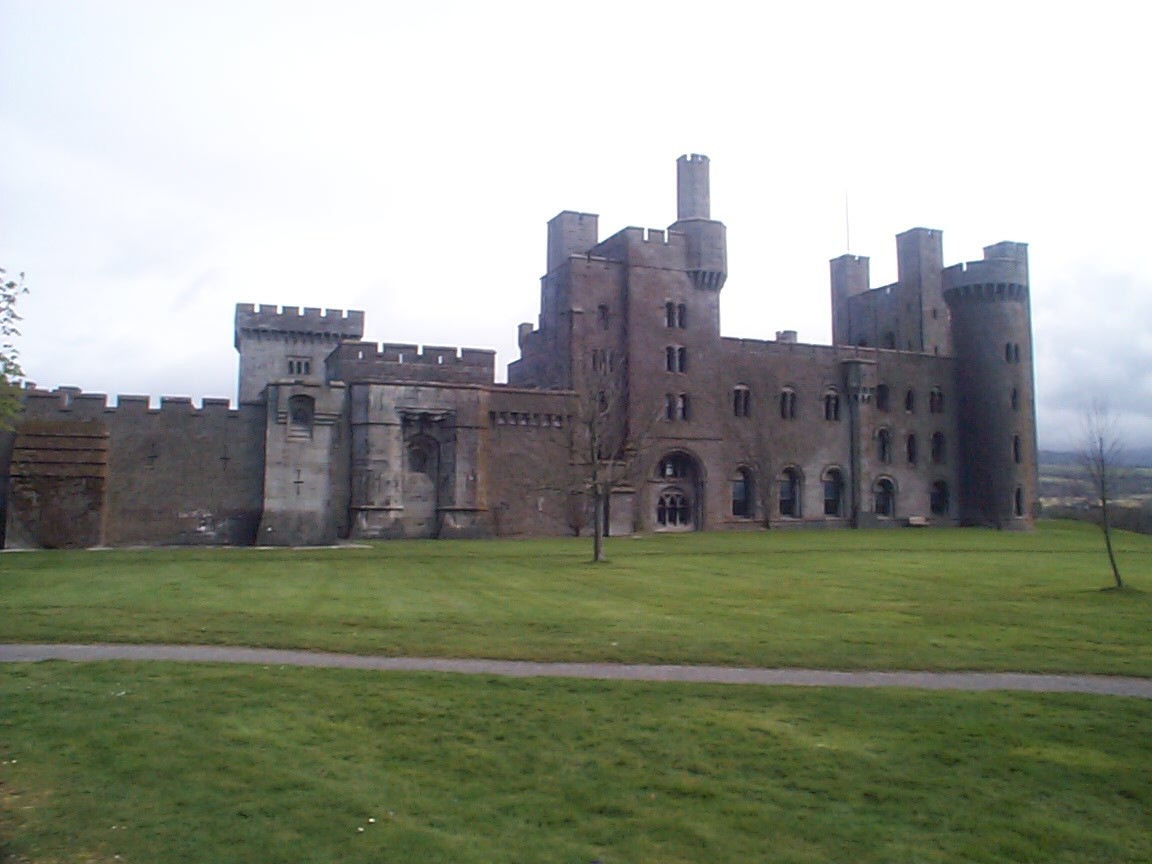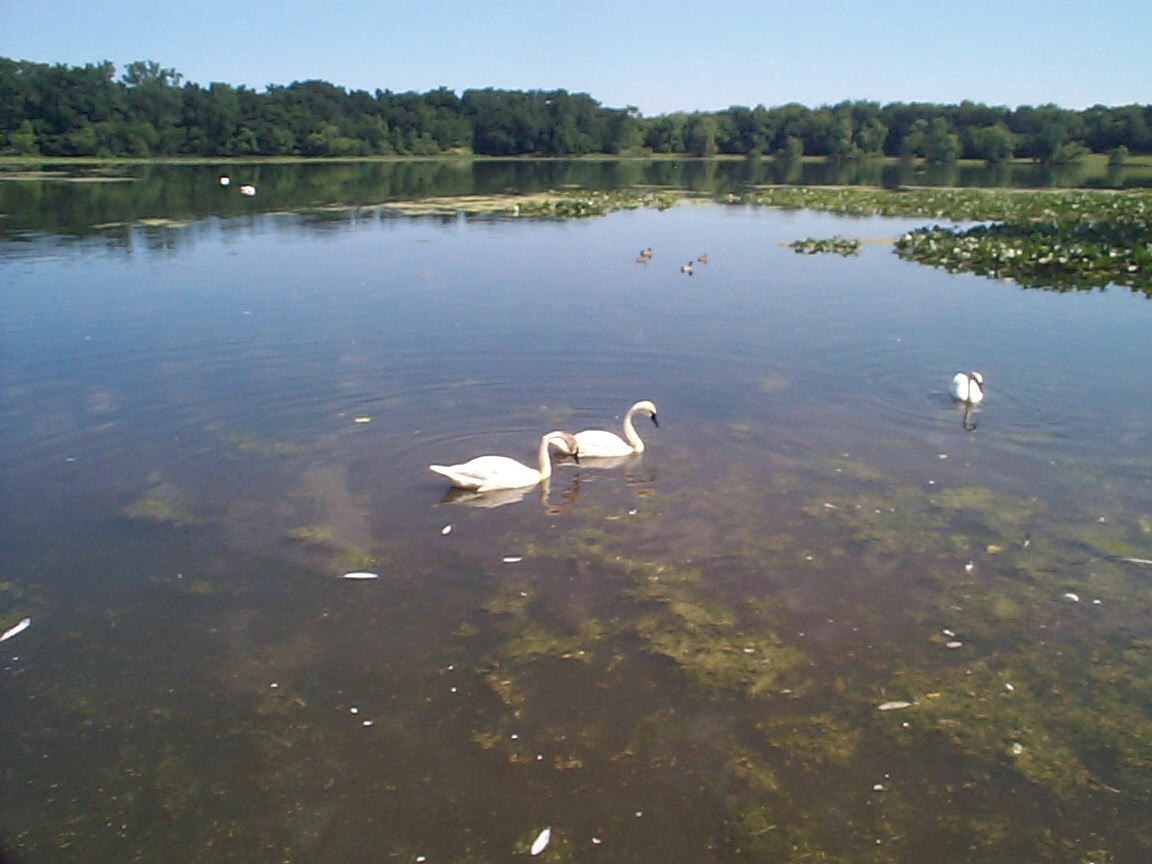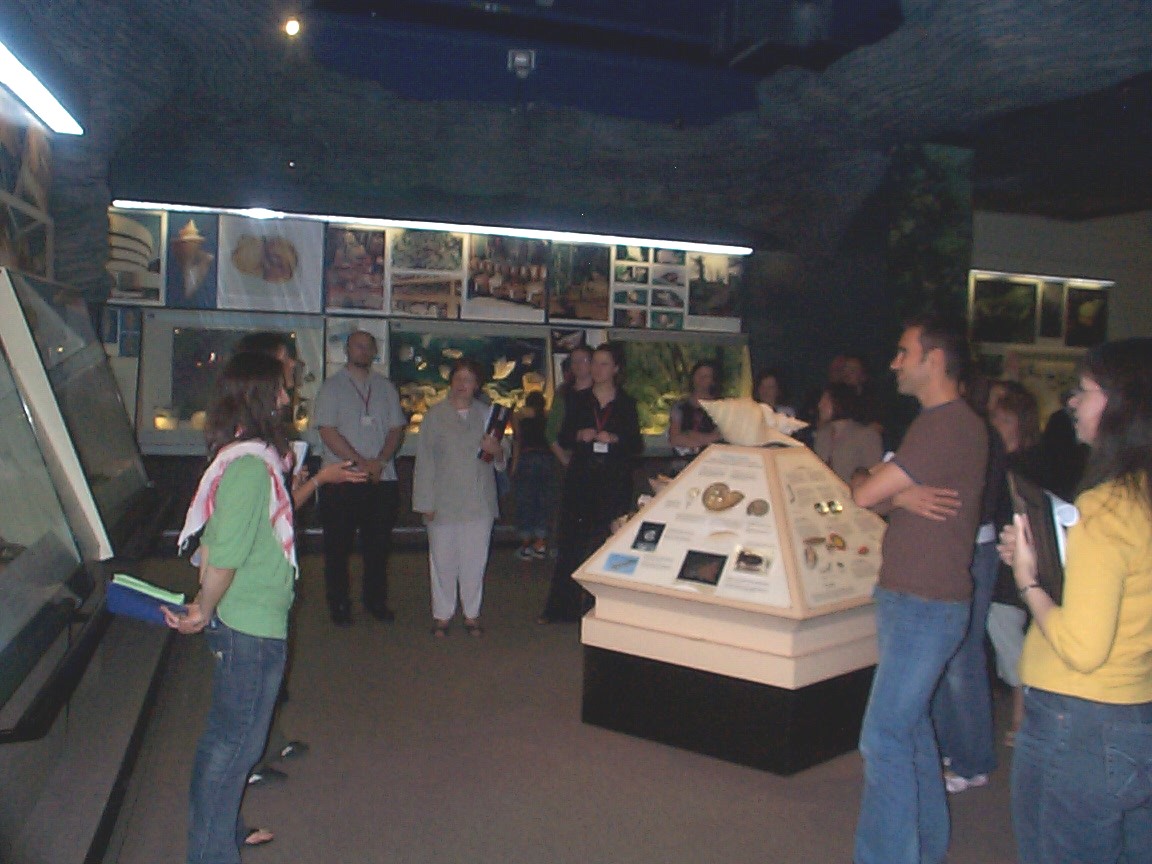|
Interpretive Master Planning keeps
your garden growing.
(Published In Roots, Volume 2,
Number 2, November 2005.) A publication of Botanic Gardesn
Conservation International.
By John A. Veverka
It’s not just botanical gardens that need the care and feeding provided by
Interpretive Master Plans – but all heritage attractions do. From parks and zoos to
other heritage areas – they all need interpretive master planning to keep them
growing. Of course by growing I mean that they can create interpretive programs, services
and media that are 1.) actually interpretive instead of just informational, 2.)
effectively communicate their main messages to visitors in a format that visitors
understand and relate to, and 3) help accomplish the main mission and goals of the
agencies involved. Thus interpretation keeps your garden growing in visitation
numbers, support by visitors and increase in memberships, and by physical growth of
interpretive programs, services and outreach activities. The Benefits of the interpretive
plan are great as well. It helps you focus the short and long term accomplishment of your
mission, helps you make long term cost effective interpretive program and media decisions,
helps develop your marketing strategy, and more. Interpretation brings in more visitors.
The interpretive plan tells you how to do it.
So why do you need interpretive planning?
First of all, you must understand that interpretive communication is the most powerful
communication process you have available to you to communicate to your visitors with. All
of the principles of interpretation come from marketing and advertising. So when you see a
powerful advertisement on the television, or in print media, they are using
"interpretive communications". You can’t communicate to your visitors
successfully without it!
What is "real" interpretation anyway?
Interpretation to some is a word like "ecology". We hear the word but most of
us have never actually seen one because it is a process of interrelationships more
than a "thing". Interpretation is like that in that you may have never actually
seen any media or exhibits that were really interpretive! Does that provoke you?
First let’s take a look at the definition of Interpretation – yes there really
is one!
Interpretation is a communication process designed to REVEAL meanings
and relationships of our natural and cultural heritage to visitors
through first-
hand involvement with objects, artifacts, landscapes, build features,
experiences and sites.
To be "interpretive" the communication process must follow or be based on Tilden’s
Interpretive Principles. That is, the interpretive communication process must:
Provoke attention, curiosity or interest in the visitor.
Relate to the everyday lives of the visitors. (Why would a visitor want to know
this?)
Reveal the main essence of the story message in a memorable way (the Oh My
effect).
Address the whole – that is work to illustrate a common theme, message
or "big picture" concept for the visitor – the one main idea you want them
to take away.
Strive for message unity – use the right supporting/design materials (sounds,
colors, materials, graphics, etc. that thematically support the message).
So when we develop an Interpretive Master Plan, the job of that interpretive plan
is to insure that these interpretive techniques and principles are used throughout the
total site interpretive presentation – trails, outdoor displays, live programs,
visitor center exhibits and other related media.
Here are some examples of "interpretive" exhibits from the Frederick Meijer
Gardens in Grand Rapids Michigan. These are in their "children’s" garden.
Each of these exhibit areas with their activities "Provokes" your attention,
"relates" to the everyday lives of the visitor, and has a "revelation"
to its message. In this case all of the exhibits relate to the senses the children can use
in enjoying and exploring the garden.


What is an Interpretive Master Plan?
Imagine your garden as a 500 piece puzzle. What visitors see as they move through the
grounds may very well be these puzzle pieces in random order, not receiving a clear
message of who you are, what you do, and why you do it (your mission). What an
interpretive plan does is provide the picture on the cover of the puzzle box for both the
visitors and for you. It helps you organize your main messages for visitors so they can
clearly understand them throughout their visit, and your strategy to create and deliver
those messages through media and services at key interpretive sites and areas.
The Parts of an Interpretive Master Plan.
It is probably easiest to look at the Interpretive Planning process in the form of a
model as shown below:
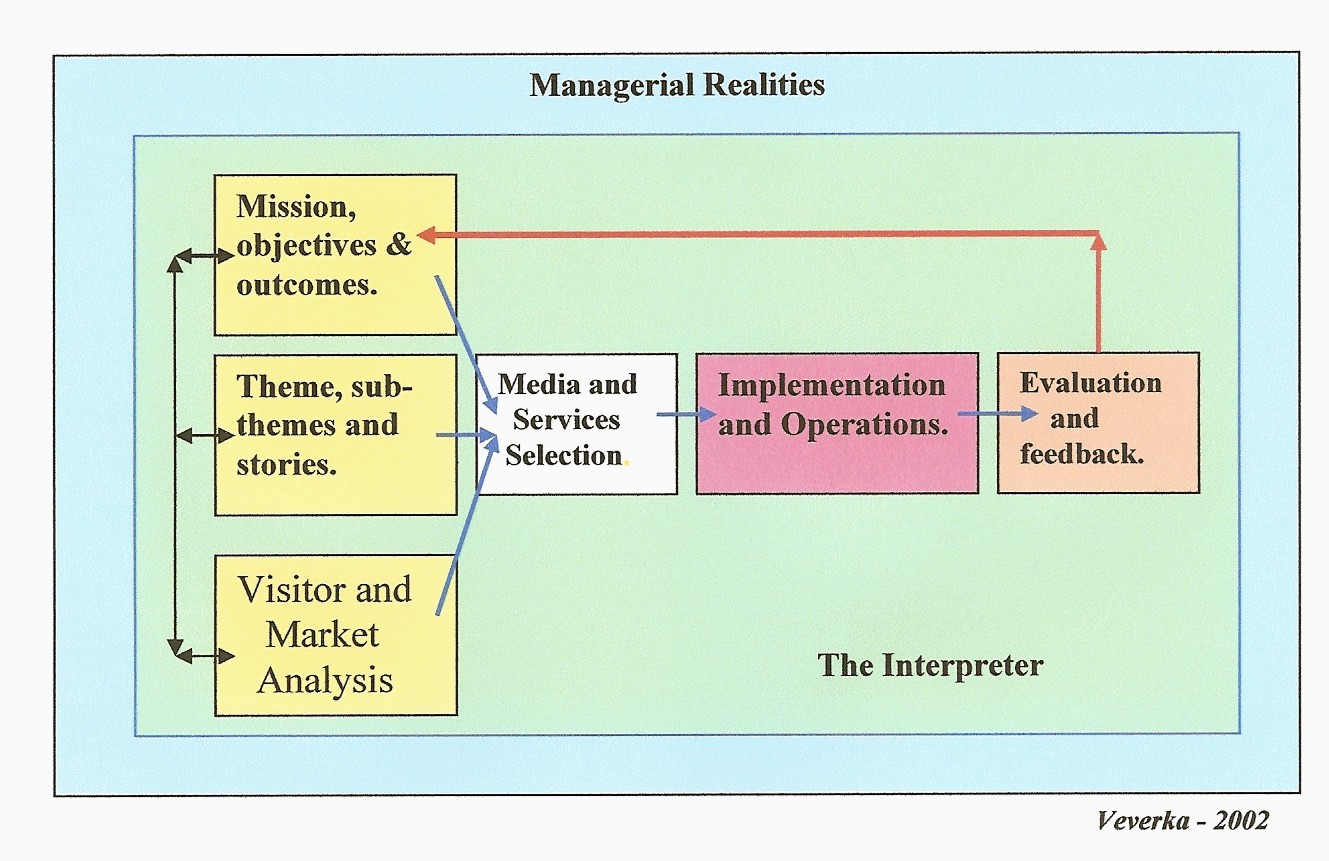
We can think of the interpretive planning process in sections.
First you see the large box in the model called managerial realities. These are
issues that you might have problems with: budget, available staffing, political support,
time, existing policies or directives, mission, etc. We identify these at the start of the
interpretive planning process so we can do the plan with these constraints in mind.
Then find the big box that all the parts reside in called "The Interpreter".
That’s you if you’re the interpretive planner, or your planning team.
There’s always more than one right answer, and each interpreter or team brings their
own unique values, ideas, creativity and knowledge to the project. Within this big box is the
process, which I have divided into sections or tasks:
Section I – includes three components.
For the interpretive plan we must clearly identify, write, or create the specific objectives
that we want interpretation to accomplish for the total Botanical Garden experience
for visitors. These include Learning, Behavioral and Emotional objectives.
Here are some examples of these kinds of objectives:
Learning Objective: Upon completion of reading the interpretive panel the
majority of visitors will be able to identify three (s) key components of a plants
reproductive strategy.
Emotional Objective: Upon completion of their visit to the Botanical Garden the
majority of visitors will value and appreciate their native plants in a new and more
powerful way.
Behavioral Objective: Upon completion of their visit to the Botanical Garden 10%
of the visitors will want to consider landscaping their home gardens with native plants.
We conduct a complete inventory of all interpretive sites and resources where we
want to have some interpretation take place. From this inventory of interpretive sites and
features we then develop our main interpretive theme, sub-theme and story line that
we want to present and illustrate to visitors. In general we may inventory:
G – Geological sites and Features
B – Botanical Habitats
BD – Botanical Demonstration Areas.
SBD – Seasonal Botanical Demonstration Areas.
F – Facilities (Interpretive Centers, Gift shops, etc.).
H – Historical sites, facilities or features.
R- Research sites, demonstrations or programs.
I generally give each category a code (G = Geological, etc.) as a way of grouping
interpretive resources. These codes will appear on our standard interpretive planning
forms to help identify each unique interpretive site or feature within the property. So if
we have seven different biological habitats within the garden, each will be coded as: B-1,
B-2, B-3 and so on.
We also need to know as much about our visitors as possible. Who they are, where
they come from, age groups and related demographics, seasonal visitation patterns, and
their main motivations for the Garden visit. What do THEY want to know, learn, or
experience with you today?
Section II - In Section II of the plan we look at all of the sites that are part of
the inventory, and look at the objectives we want to accomplish Garden wide. Then we begin
to match up the objectives with the locations. We use a standard interpretive planning
form set to record this. For each planning form for each individual site we include:
Interpretive Significance of the site or feature (why are we interpreting it?).
Interpretive concept we want to use this site to illustrate (ecological principle,
adaptation, stewardship issues, etc.).
Site Objectives – things we might need to do to prepare the site for
visitors, such as add a paved walkway, viewing area, benches, etc.
Interpretive Objectives. These are the main ideas or concepts that we want the
visitors to learn, feel, or do. The DELIVERABLE for that sites interpretation.
The recommended media to accomplish those objectives, such as an interpretive
panel, demonstration planting, live program, interactive exhibit, self-guiding booklet or
other media or services. Also the estimated costs for developing those media.
A sample of completed interpretive planning form sets can be obtained by contacting the
Author at jvainterp@aol.com who will be happy to E-Mail you examples.
Section III – Section III of the interpretive master plan is the
Implementation and Operations section. I usually do a summary matrix of all the
interpretive sites. On the vertical axis are the recommended interpretive sites from the
inventory. On the horizontal axis are the recommended media, fiscal year, and costs. This
way I can do a 3-5 year implementation strategy for implementation/budgeting the total
interpretive plan programs, services, and media.
Section IV – One of the most important parts of the interpretive plan is the
EVALUATION section. It is critical that you provide a strategy for pre-post testing
any/all new interpretive programs, services and media to make sure they are accomplishing
their objectives. If you paid $2000.00 for an interpretive exhibit – do you have
proof that you are getting $2000.00 in BENEFITS from that exhibit?
What are the Benefits of doing an Interpretive Master Plan?
It helps you organize your presentation to the visitors as to why the botanical
garden has value – to them (the visitor), to the community, and perhaps regionally or
nationally.
It is the interpretation (programs, guided tours, exhibits, and experiences, etc.) that
visitors come to the gardens for – the story and site experience. It help them to
understand what they are seeing in real terms. Interpretive services are one of the main
reasons visitors come back to botanical gardens parks, and other related sites.
Carefully planned interpretive programs and services can help increase visitation by
increasing the perception of BENEFITS visitors receive by going to a particular facility,
garden or site.
Interpretive programs and services provide added value to any botanical garden
experience and are important aspects for site marketing efforts and membership
recruitment.
You cannot have ecological tourism without interpretation. Ecological tourism is
dependent upon the story of the site and the willingness of visitors to want to travel to
see, learn about and experience the site.
Well-planned and evaluated/updated interpretation brings in more visitors, more repeat
visitors and more income.
The interpretive plan provides interpretive strategies to allow visitors create their
own unique choice of ways to experience and learn about a site and its story (mass
customization).
The interpretive plan organizes the Gardens sites, trails, experiences and stories in a
way that helps protect the resource while engaging and inspiring visitors.
You will find it very hard to accomplish your overall mission and objectives using less
effective communication strategies. Through your Interpretive Master Plan you also create
a media plan, marketing plan, and long term development plan as well.
The Interpretive Master Plan is your way to insure that your messages are truly
connecting with, and being understood by your audience in the most cost effective way
possible. Can you truly be successful with out one?
Summary
An Interpretive Master Plan provides the strategy to insure that your sites messages
are truly connecting with, and being understood by your audiences in the most cost
effective and powerful ways possible. It helps you identify the most effective media and
services to deliver your messages, engage and inspire your visitors, and increase
visitation and memberships.
The Benefits of the Interpretive Plan are huge. It helps your to focus on both short
term and long term strategies to accomplish your mission. It helps you develop a phased-in
strategy for implementing new interpretive programs, services, and media. It provides a
key tool in grant writing – knowing your audience, objectives, media and costs up
front. And it helps you grow your audience, as well as your site. It keeps you focused on
a real set of deliverables over a 5-year time frame or phasing strategy. And it provides a
way for you to evaluate your programs and services to see if they are really working. It
is your managerial "green thumb" for connecting your site to your visitors in
the most imaginative and powerful and cost effective way possible.
John Veverka is president of John Veverka & Associates, an international
interpretive planning and training firm located in Michigan, USA. John has 30 years of
interpretive planning experience and is a Certified Interpretive Planner and Trainer, and
a Certified Professional Heritage Interpreter. He is the author of the textbook
Interpretive Master Planning. John has a wealth of interpretation articles available for
you to copy at his web site LIBRARY at www.heritageinterp.com. If you have any questions
you can contact John directly at: jvainterp@aol.com.
References:
Tilden, Freeman. Interpreting our Heritage. University of North Carolina
Press. 1954
Schmitt, Bernda H. Experiential Marketing. The Free Press, 1999.
Veverka, John A. Interpretive Master Planning. Acorn Naturalists. 1994
You can obtain a copy of John’s Textbook "Interpretive Master Planning"
from Acorn Naturalists (publisher) at http://www.acornnaturalists.com .
Implementation and Priorities Matrix
Index # Media/Services 04 05 06 07 08 Cost Estimates
PF-3 Proposed New Amphitheater
- Develop a landscape design plan for the proposed amphitheater. XX $8000.00
Plan the design to provide seating for about 300 visitors. XX
Provide a paved handicapped trail/path access to the top
seating of the amphitheater.
Develop electrical support for loud speaker, AV equipment
projection, and multi-purpose stage.
Allow extra terracing for lawn-chair seating if needed.
Have a central campfire ring that could be covered when not in
use for evening programs, cookouts, cooking demonstrations,
etc.
PF-4 Proposed Wildflower Center
Review barn construction for future use.
Provide for facility security (locking doors).
Develop seasonally changing interior exhibits. $10,000.00
Purchase video exhibits on song birds and related topics. $600.00
Purchase large plasma screen video for wall mounting. $6000.00
Develop an interior design plan for sales and exhibits.
Exterior painting for room, entrance and silo.
PD-6 Wildflower Demonstration Area
Develop exterior landscape plan for demonstration areas. Costs to be determined.
Plan for visitor flow to and through the demonstration plots.
Develop changeable demonstration interpretive signage plan.
Develop a site management plan.
| 